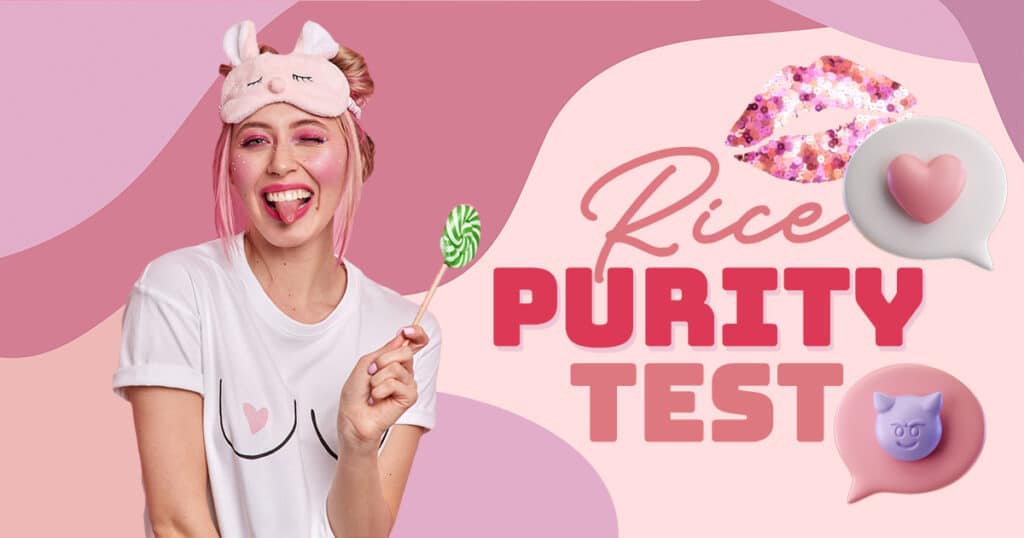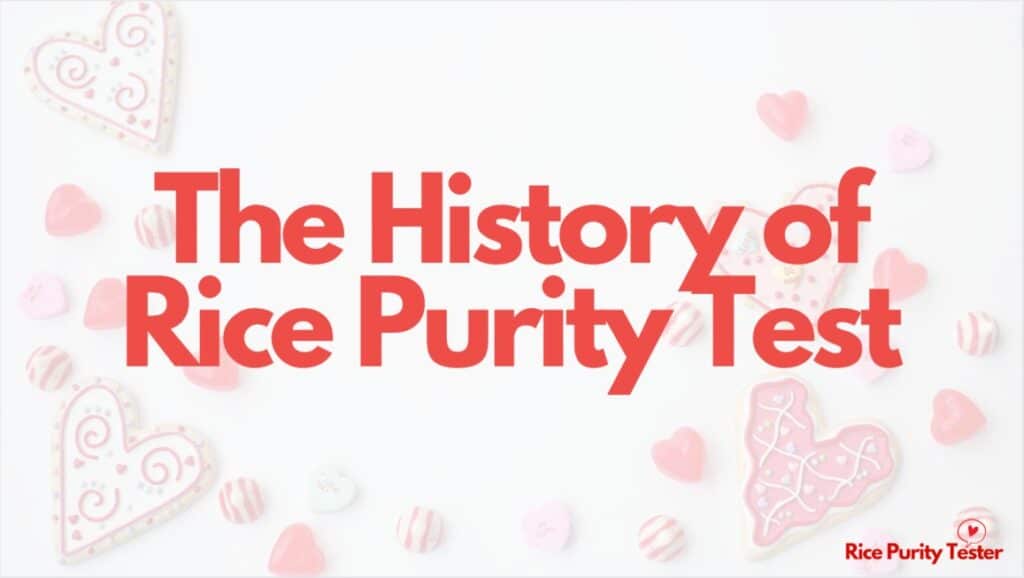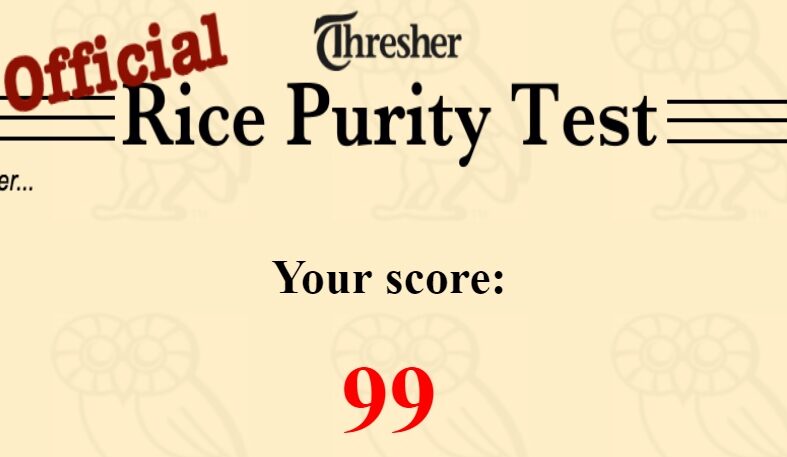Welcome to an intriguing exploration of the Rice Purity Test. In a world where social norms and experiences shape our understanding of ourselves and others, the Rice Purity Test offers a unique lens through which we can examine our past behaviours and experiences.
This article delves into the fascinating world of the Rice Purity Test, uncovering its origins, purpose, and impact it has had on individuals and communities, from decoding the questions to understanding their cultural significance.

We embark on a journey that invites reflection, self-discovery, and a deeper understanding of the complexities of human experiences. So, let’s dive into the realm of the Rice Purity Test and discover what it reveals about our own journeys.
Read Also: The Pizza Edition: A Comprehensive Review
What is Rice Purity Test?
The Rice Purity Test is a questionnaire or survey that aims to assess an individual’s level of innocence or purity based on a series of questions about their past experiences and behaviours. It originated at Rice University in the 1980s as a way for students to compare their experiences and gauge their “purity” in a playful manner.
The test consists of a list of around 100 questions that cover a wide range of topics, including relationships, sexual activities, drug use, and other behaviours. Each question asks the participant to indicate whether they have engaged in a particular activity or experienced a certain situation.
The participant then assigns themselves a score based on their “impurity,” with a lower score indicating a higher level of innocence or purity.

While the Rice Purity Test is often taken for fun or as a conversation starter, it has gained popularity as a way for individuals to reflect on their past experiences and compare them with others. It can spark discussions about societal expectations, personal values, and cultural differences.
It’s important to note that the Rice Purity Test is not a scientifically validated assessment, and its results should not be taken too seriously. It is purely a recreational activity and should be approached with a sense of humour and lightheartedness.
This article will explore the origins of the Rice Purity Test, its cultural significance, and the controversies surrounding it. We will also examine the ways in which individuals engage with the test and the broader implications it may have on discussions of personal experiences, societal norms, and the concept of purity itself.
Related: Smile Dating Test
What Age Grade is the Rice Purity Test Meant for?
The Rice Purity Test does not have a specific age grade it is meant for, as individuals of various ages can take it. However, it is important to note that the test covers a wide range of topics, including sexual activities and experiences that may not be appropriate or relevant for younger individuals.
Given the nature of some of the questions, it is generally more common for the Rice Purity Test to be taken by college students or young adults who are of legal age to engage in certain activities. It is often seen as a lighthearted activity among peers and can serve as a conversation starter or a way to compare experiences within a specific social context.

Parents or guardians should exercise caution and discretion if they become aware that younger individuals, especially minors, are taking the Rice Purity Test. It is advisable to consider the age appropriateness of the questions and the potential implications of discussing certain topics with individuals who may not have the necessary maturity.
Ultimately, the decision to take the Rice Purity Test or allow younger individuals to participate in it should be made carefully considering their emotional readiness and the appropriateness of the content for their age group.
Related: Time Capsules: Importance and How To Create One
Average Rice Purity Test
The average Rice Purity Test score can vary widely depending on the individual and their personal experiences. Since the test covers a range of activities and behaviours, including sexual experiences, drug use, and other factors, the average score can be influenced by cultural, societal, and individual factors.
It’s important to note that the Rice Purity Test is not a scientific or standardized assessment but rather a fun and informal questionnaire. Therefore, there is no definitive “average” score for the test.
That being said, it’s common for individuals to have scores that fall somewhere in the middle range of the possible score spectrum. Some people may have higher scores, indicating a higher level of perceived purity or fewer experiences in the listed categories, while others may have lower scores, indicating a broader range of experiences.
It’s essential to remember that the Rice Purity Test is not meant to judge or evaluate someone’s character or worth based on their score. It is simply a recreational activity that prompts reflection and discussions about personal experiences and societal norms.
Ultimately, the average Rice Purity Test score is subjective and can vary greatly depending on the individual’s demographic and cultural context.
Related: Roblox Unblocked 2023: The Ultimate Free Guide
How to Check the Purity of Rice
Checking the purity of rice involves assessing its quality and determining whether it has been adulterated or contaminated. Here are some steps you can follow to check the purity of rice:
1. Visual Inspection
Examine the rice visually. High-quality rice grains should be uniform in size, shape, and colour. Look for any discolouration, unusual spots, or foreign particles.
2. Smell Test
Take a small handful of rice and smell it. Good-quality rice should have a pleasant, neutral odour. If you detect any off-putting or musty smells, it could indicate spoilage or contamination.
3. Texture Check
Run your fingers through the rice grains. The grains should feel dry, smooth, and free from any stickiness. Avoid excessively damp or clumpy rice, as it could be a sign of moisture or poor storage conditions.
4. Cooked Rice Examination
Cook a small portion of the rice and inspect it after cooking. High-quality rice should have separate, fluffy grains that retain their shape and texture. If the rice turns excessively mushy, sticky, or clumps together, it may indicate poor quality.
5. Visual Inspection
Examine the rice visually. High-quality rice grains should be uniform in lumps together, it may indicate poor quality
6. Floating Test
Fill a bowl with water and add a handful of rice to it. Good-quality rice will generally sink to the bottom, while impurities like stones, debris, or husk fragments may float or be easily visible. Remove any floating particles or impurities.
7. Grain Length and Type
Different types of rice have distinct characteristics. Research the specific variety of rice you have and familiarize yourself with its expected grain length, shape, and colour. This can help you identify any abnormalities or potential adulteration
While these methods can provide some indication of rice purity, they are not foolproof. For a more comprehensive assessment, you can consider having rice samples tested at a laboratory for specific quality parameters.
Remember to source rice from reputable suppliers and ensure proper storage conditions to maintain its quality and minimize the risk of contamination.
Related: Doodle for Google 2023: All you Need to Know
Benefits of taking the Rice Purity Test
Taking the Rice Purity Test can offer several potential benefits, including:
- Self-Reflection: The test prompts individuals to reflect on their past experiences and behaviours, allowing them to gain insights into their personal journey and growth. It can be a moment of self-discovery and self-awareness.
- Comparison and Conversation: The Rice Purity Test provides a platform for individuals to compare their experiences with others in a lighthearted and non-judgmental manner. It can spark interesting conversations, foster connections, and create a sense of camaraderie among peers.
- Cultural Awareness: The test can highlight differences in societal norms and values across different cultures or communities. It encourages discussions about social expectations, personal boundaries, and the ways in which cultural factors influence individual experiences.
- Education and Awareness: The questions in the Rice Purity Test cover a wide range of topics, including relationships, sexuality, and substance use. Individuals can become more informed about various experiences and behaviours by engaging with these questions, promoting a broader understanding of human diversity.
- Personal Boundaries: The test can serve as a reminder to individuals about their personal boundaries and values. It allows them to assess their comfort levels, establish their limits, and make informed choices regarding their behaviours and experiences.
- Perspective and Growth: By reflecting on past experiences, individuals may gain a broader perspective on their own growth and maturity. It can serve as a marker of personal development, showcasing how they have evolved over time.
- Humour and Entertainment: The Rice Purity Test is often taken for fun and entertainment purposes. It can provide a light-hearted activity that brings joy, laughter, and a sense of shared experiences among friends or peers.
It’s important to approach the Rice Purity Test with a sense of humour and understand that the results do not indicate one’s character or worth. It should be seen as a recreational activity that encourages self-reflection, conversation, and personal growth.
Related: Today’s Wordle Hints and Answer
Highest and Lowest points on Rice Purity
The Rice Purity Test, as originally designed, consists of around 100 questions, each carrying a certain number of points. The lowest possible score on the Rice Purity Test is 0, indicating that the individual has experienced or engaged in all the activities listed in the test.
On the other hand, the highest possible score on the Rice Purity Test depends on the specific version or variation of the test being used. Some versions may assign a maximum score of 100, while others may have a higher maximum score. The higher the score, the fewer experiences or activities the individual has participated in.
It’s worth noting that the Rice Purity Test is often taken casually and light-heartedly, and the scores are not meant to measure one’s worth or character. The purpose of the test is primarily for personal reflection, comparing experiences with others, and generating discussion rather than assigning a definitive numerical value to one’s “purity.”
The Rice Purity Test serves as an intriguing and often entertaining way for individuals to reflect on their past experiences and engage in conversations about societal norms, personal values, and cultural differences. It provides an opportunity for self-reflection, self-awareness, and a deeper understanding of one’s own journey.
While the test offers a glimpse into personal experiences and behaviours, it is essential to approach it with a sense of humour and recognize that the results do not define a person’s worth or character. The Rice Purity Test is a recreational activity that should be taken in the spirit of fun and lightheartedness.
Related:
- New York Times Wordle: The Addictive Charm of New York Times Wordle
- 100+ Best Paranoia Questions for your Games Night
- 60 Truth or Drink Questions For Your Next Hangout
- Unblocked Games World: All You Need To Know
- Tyrone’s Unblocked Games: All You Need To Know
FAQs for Rice Purity
What is a good rice purity score?
A score between 100 – 98 means you are really a very pure, innocent, and introverted person who is highly unlikely to socialise with senior groups.
What does your rice purity mean?
The Rice purity test is a series of 100 questions that aim to assess your level of “innocence” or experience in relation to a range of issues, such as crime, sex, drugs and alcohol use. Users work through the list and tick off the ones that apply to them.
What does 77 rice purity mean?
A Score between 93 and 77: This is about the average score range, which signifies that you are not an averagely pure person.
What does the rice test score mean?
A person’s Rice Purity Score is meant to indicate their history with alcohol, sexual acts, hard drugs, and illegal actions that allow them to understand their degree of innocence. If someone has a score from 100-90, they are considered very pure. The lower your score, the less “pure” you are.
What is the lowest possible rice purity score?
A score of 100 indicates that a person has not had much sexual or romantic experience, while a score of zero would include experiences such as “bestiality” and “being convicted of a crime”.
Why is it called rice purity test?
The Rice Purity Test is a survey first administered by Rice University in 1924. The test asks 100 yes-or-no questions to output a numerical score, with 100 being the “most pure” and 0 being completely “impure.” The first test was given only to women for Rice to gauge how risqué their female population was.
